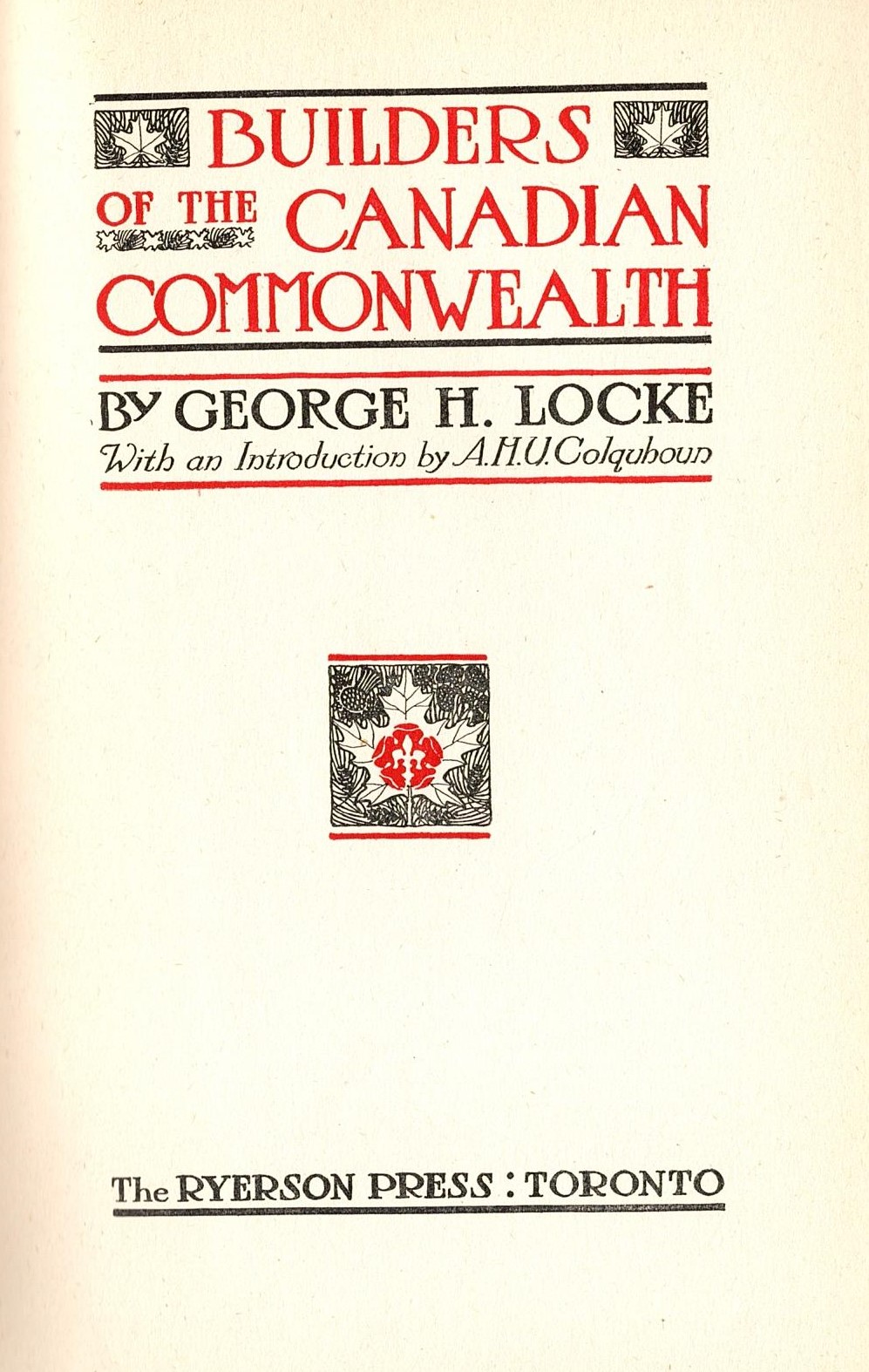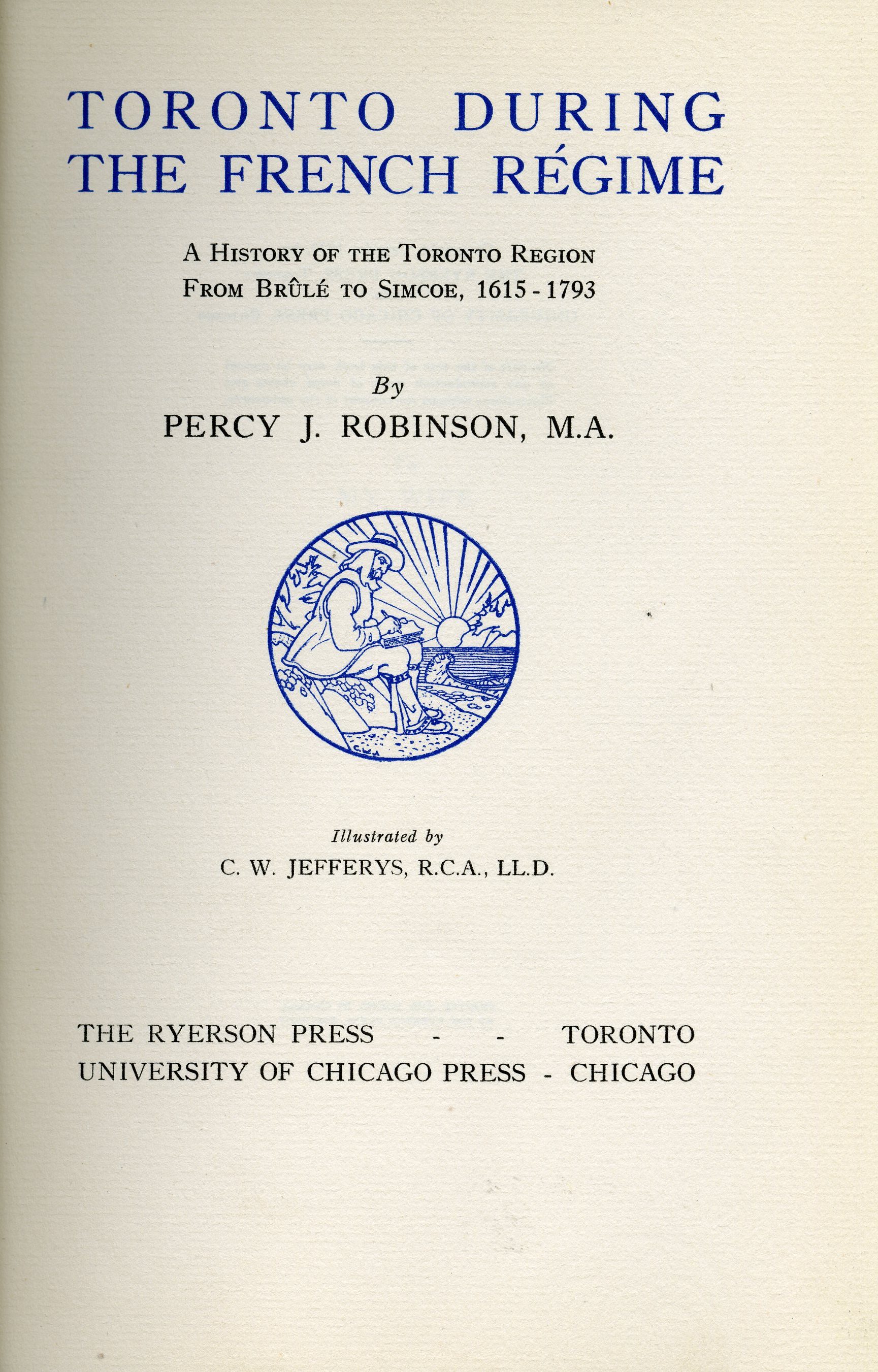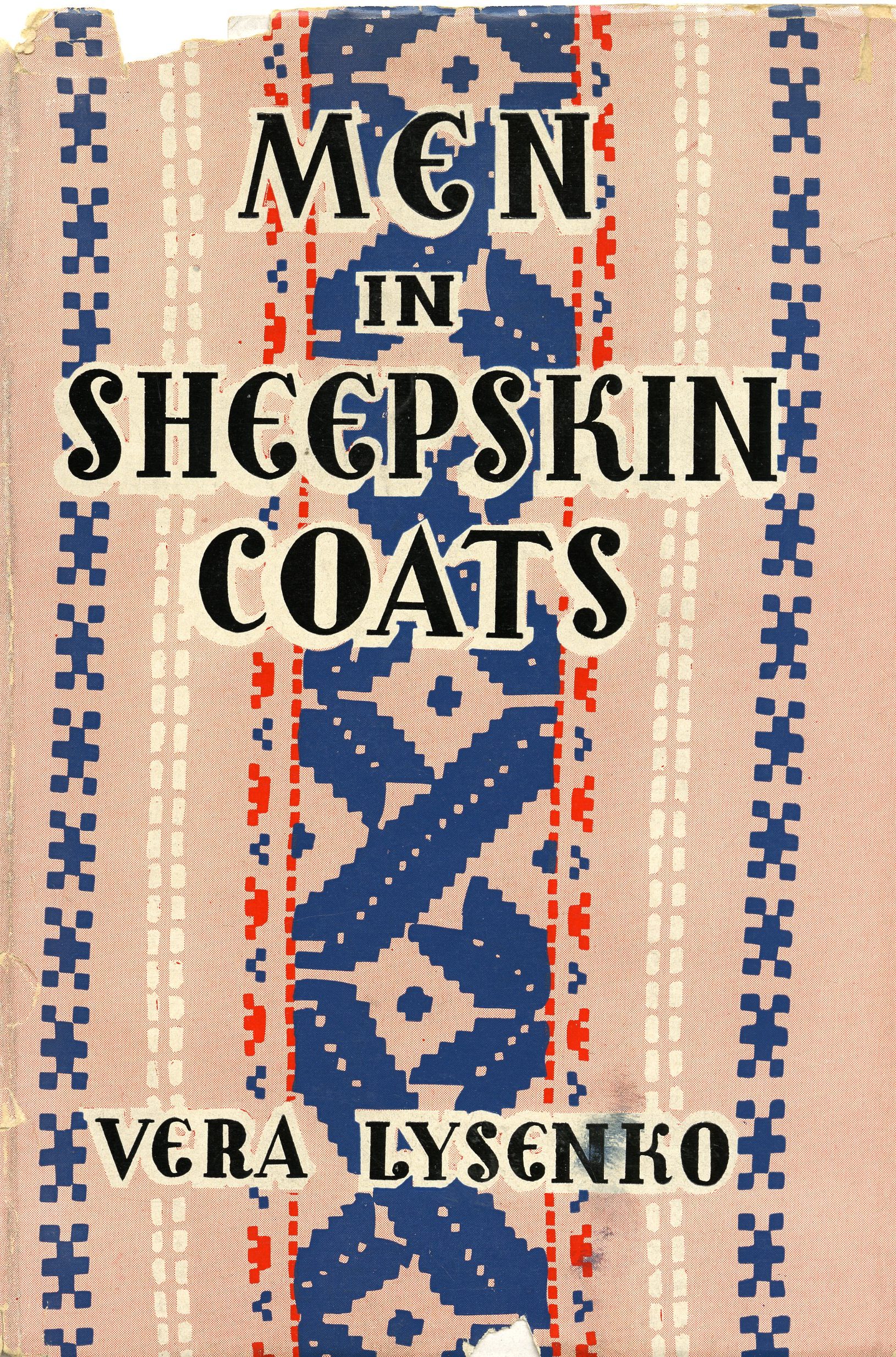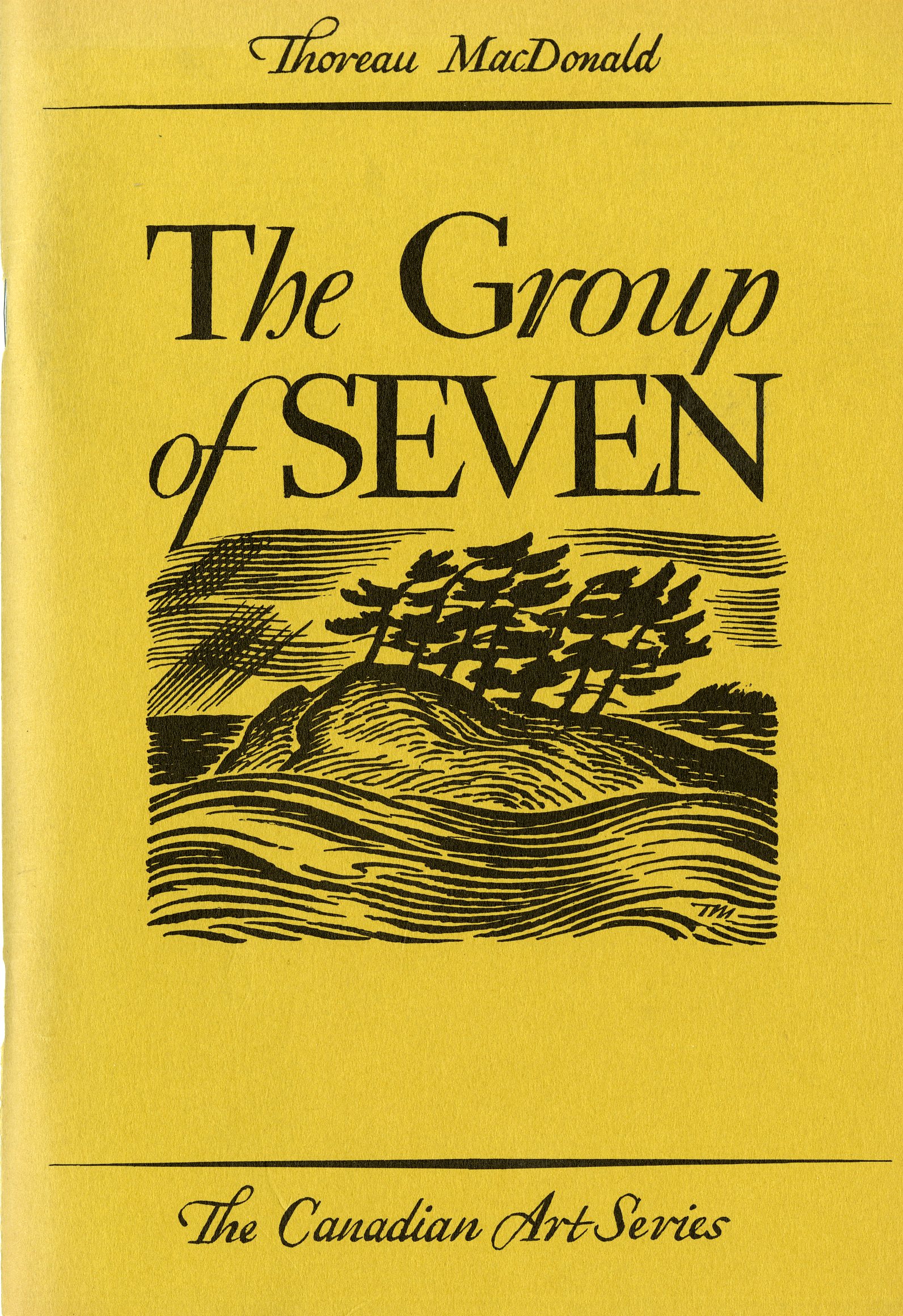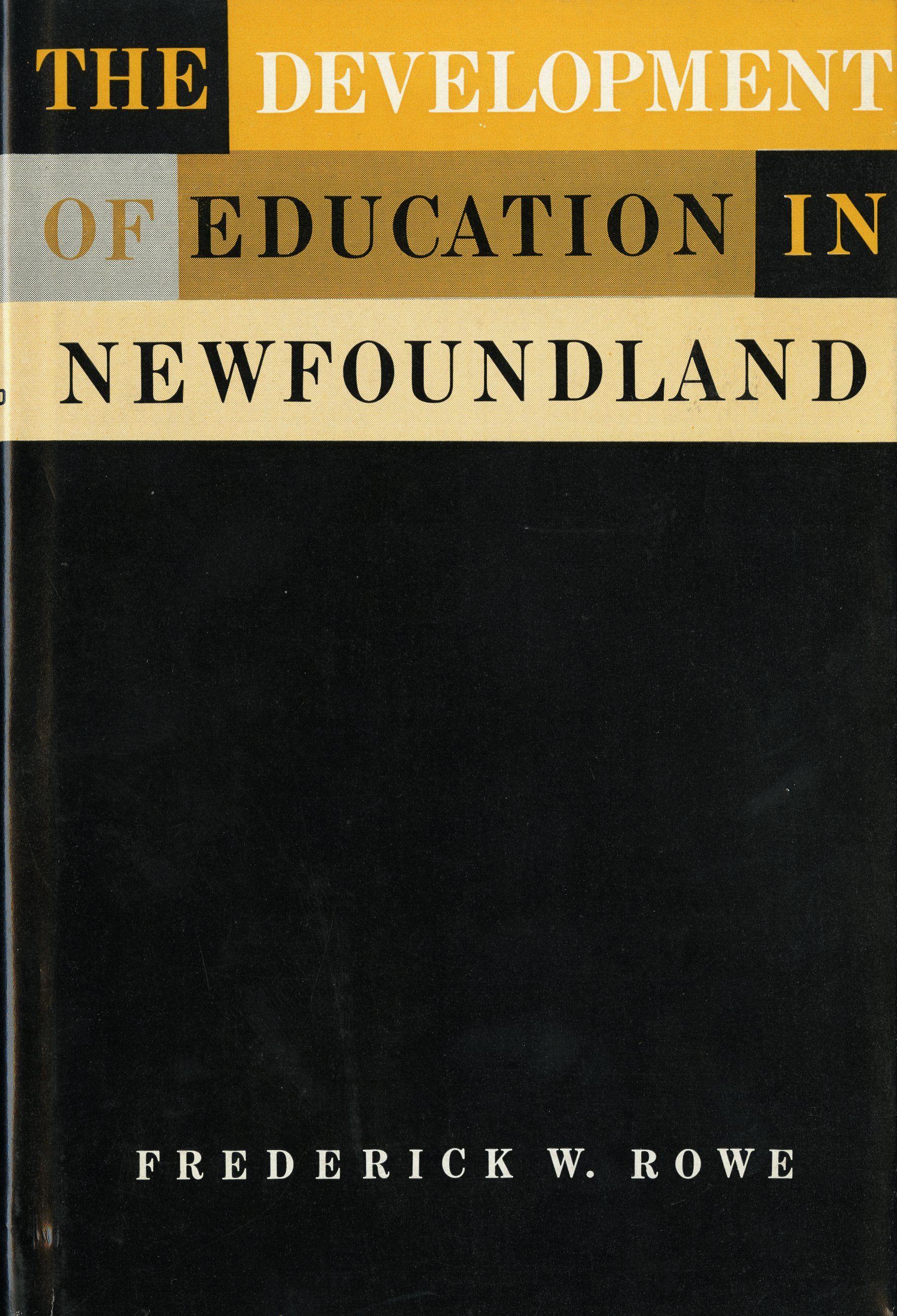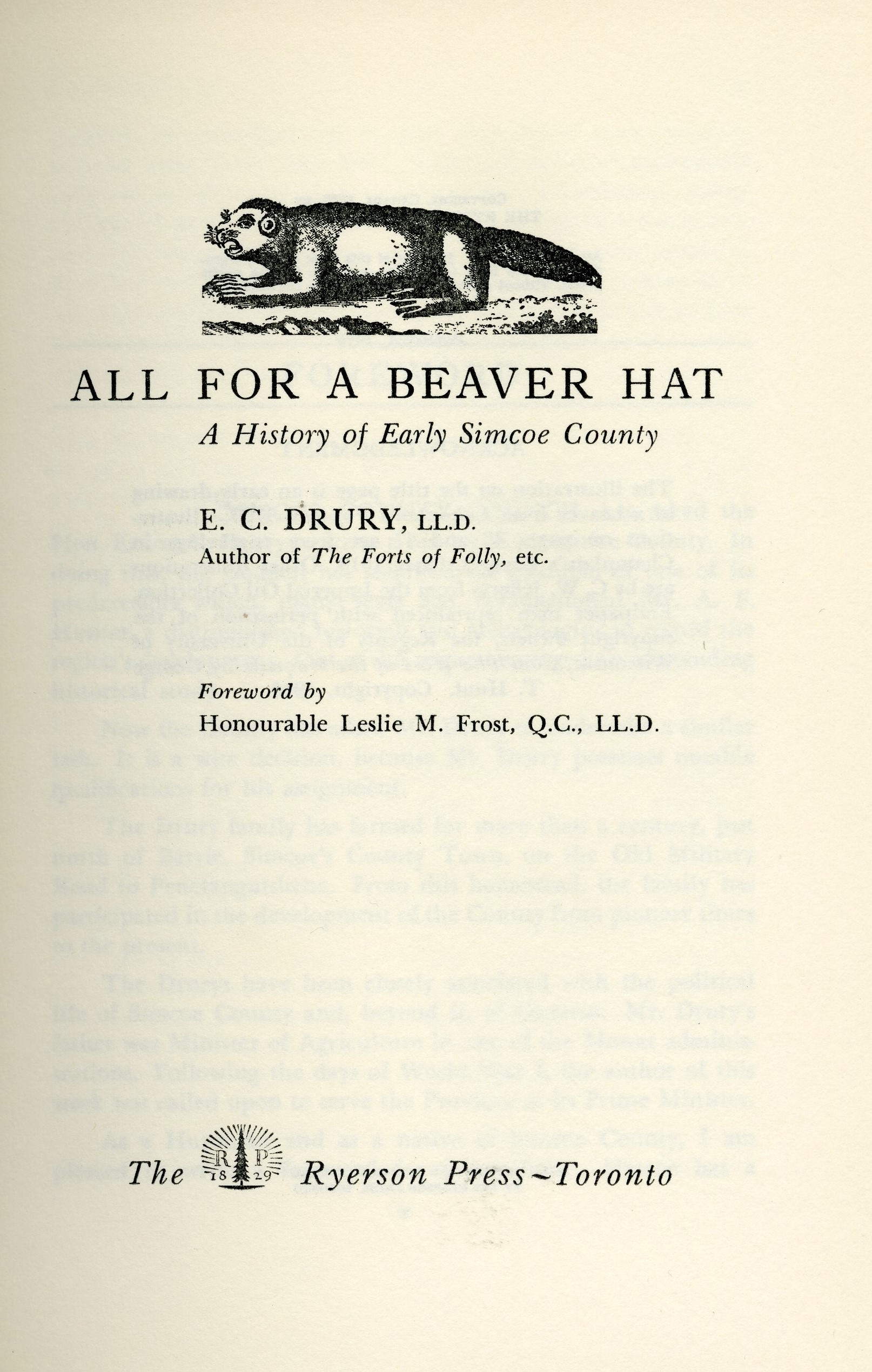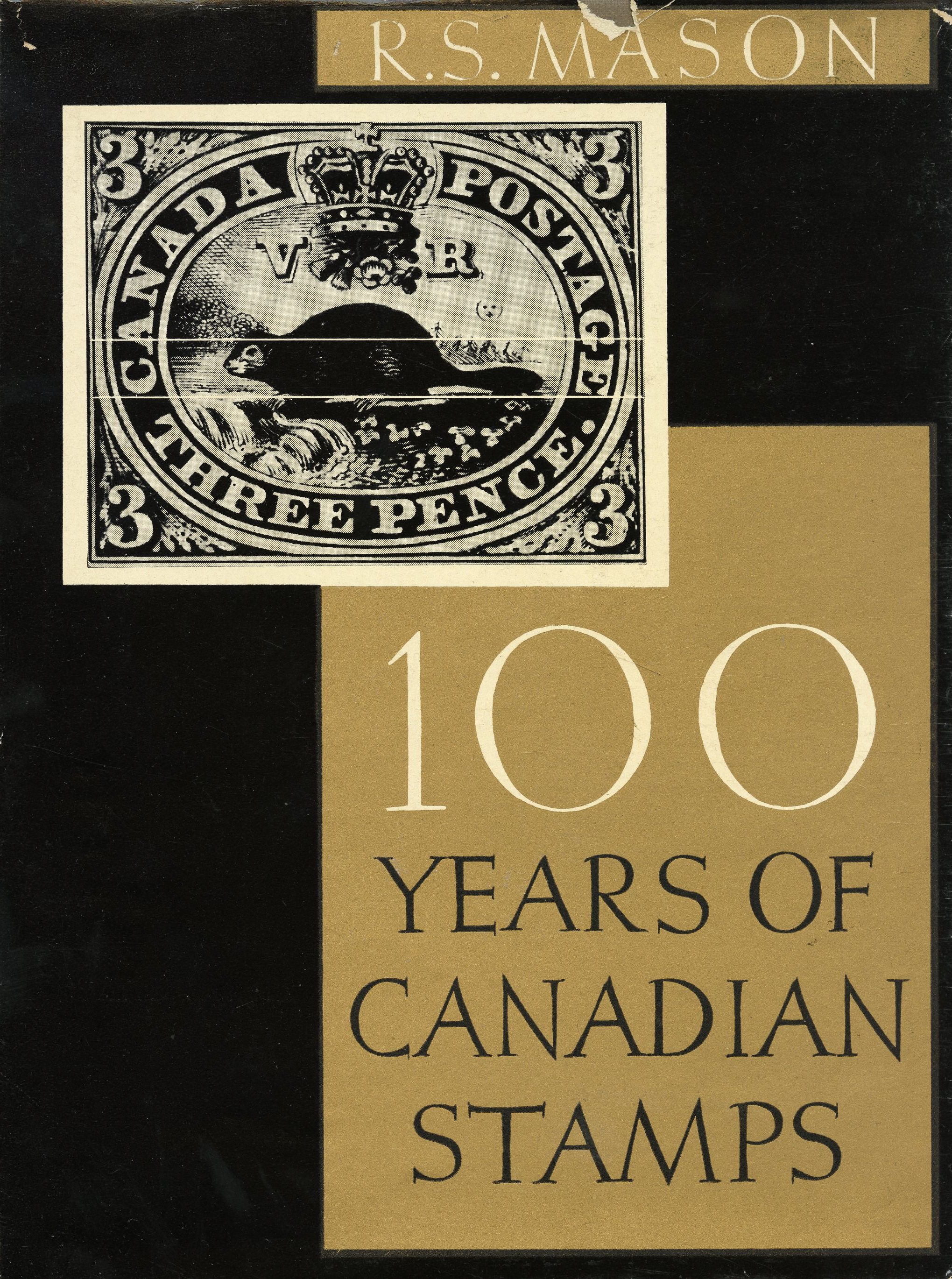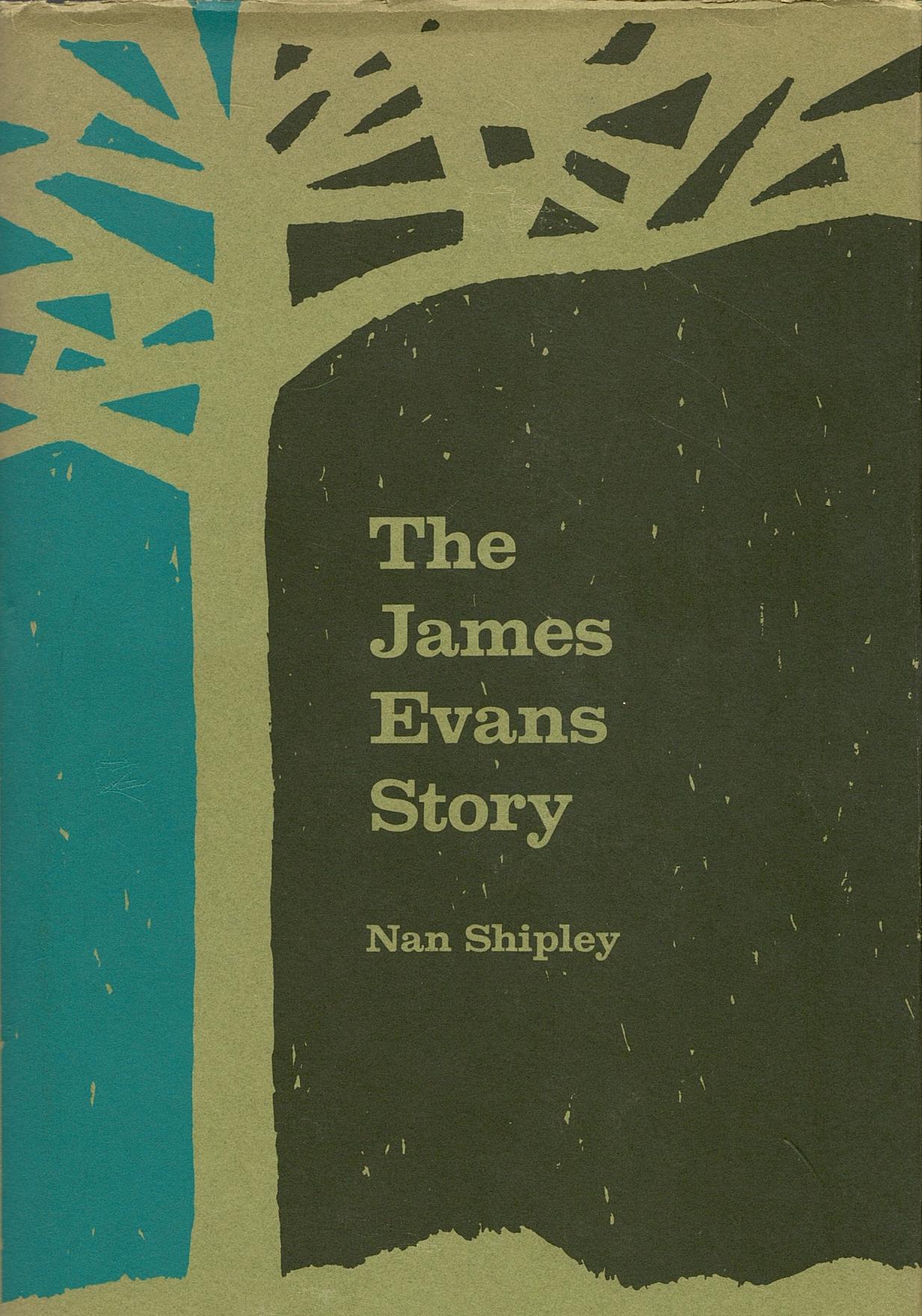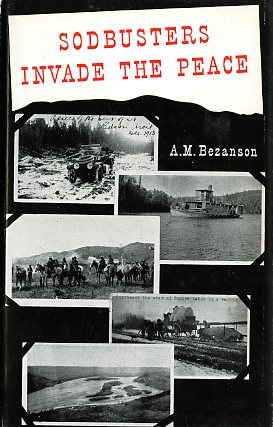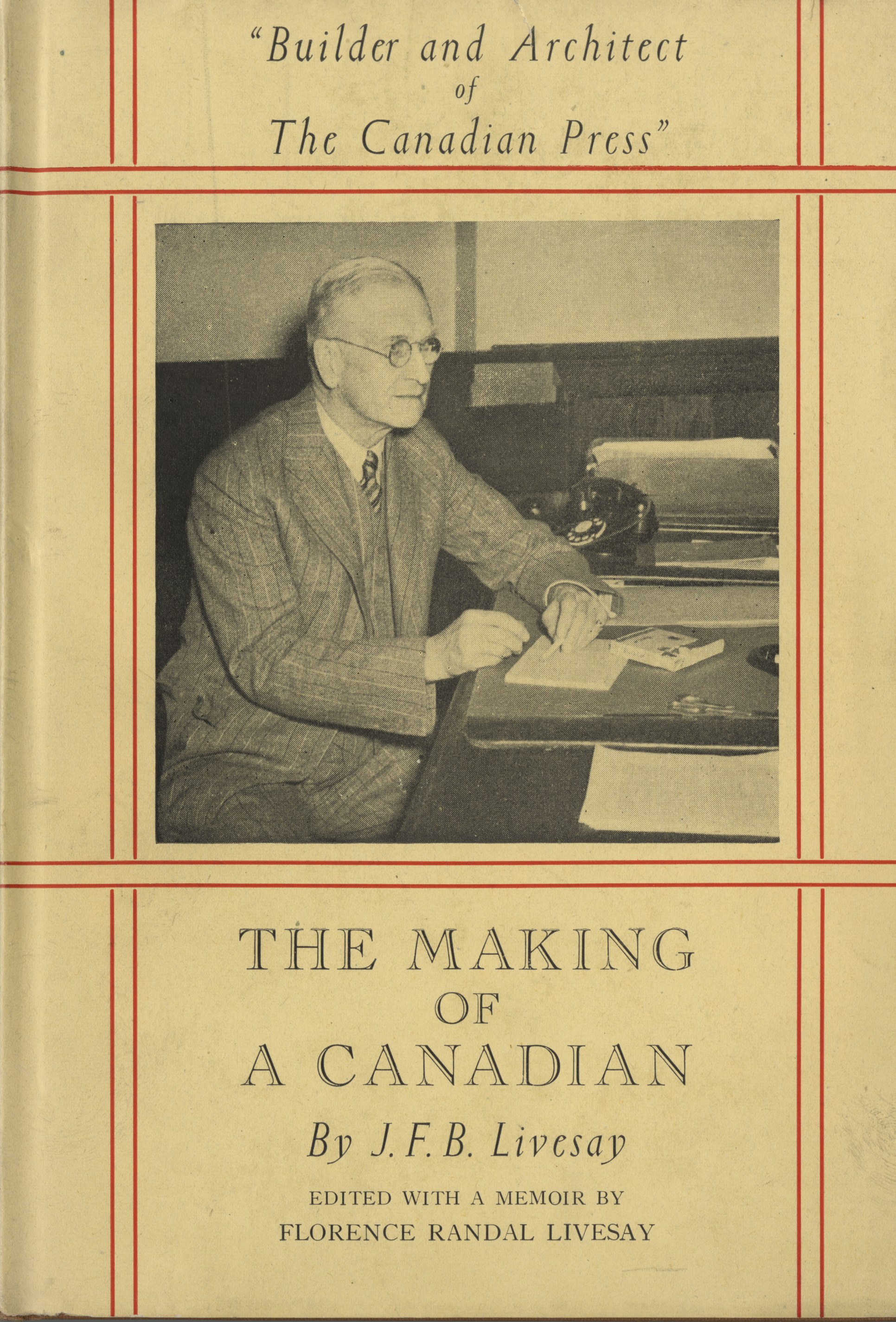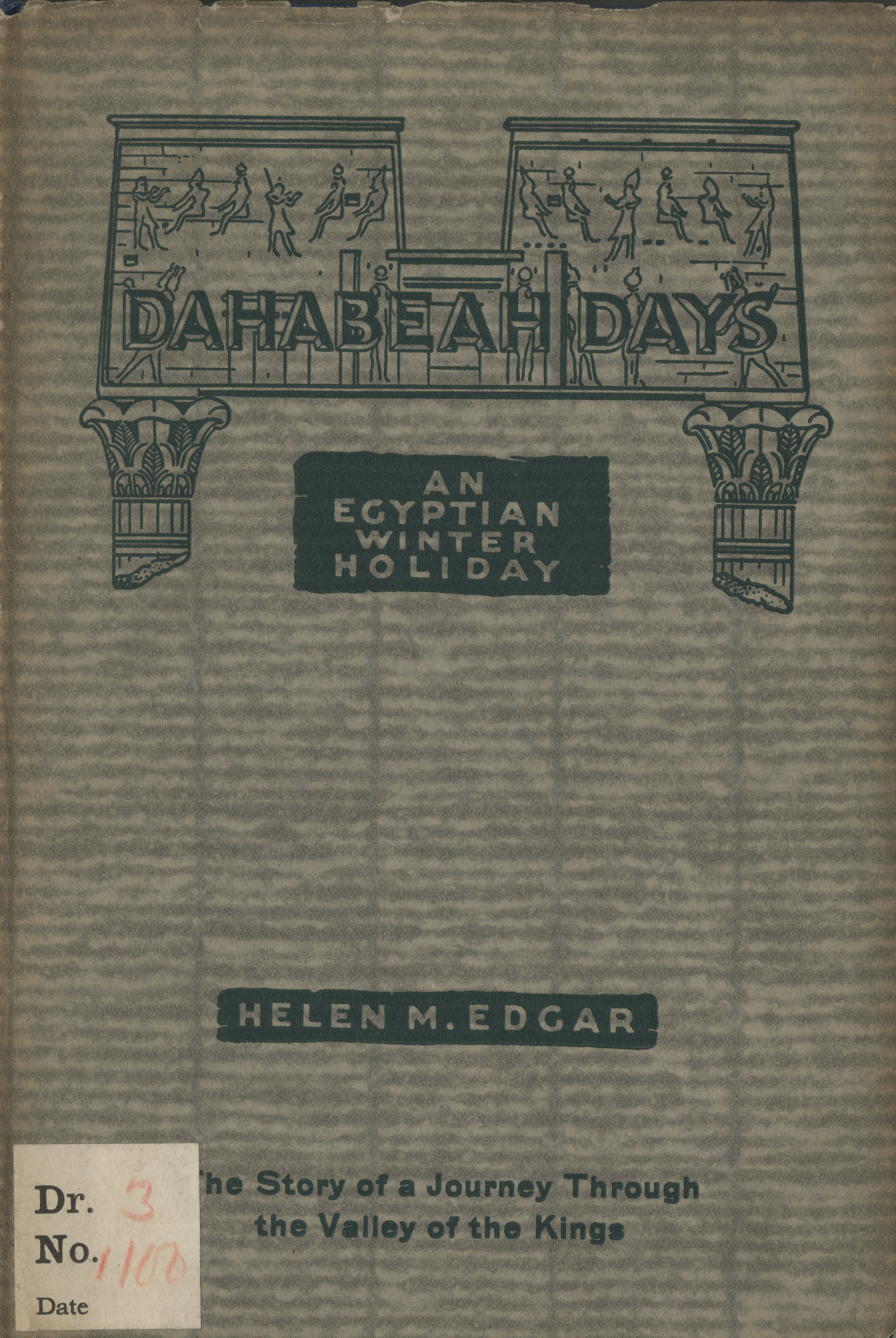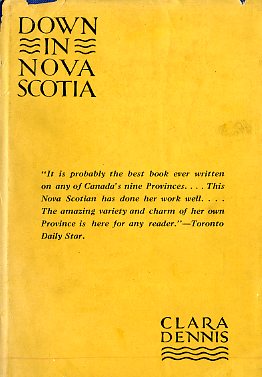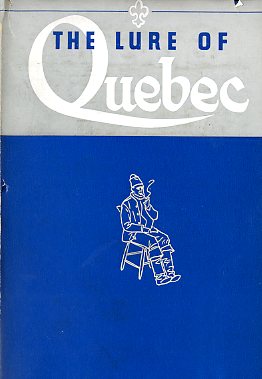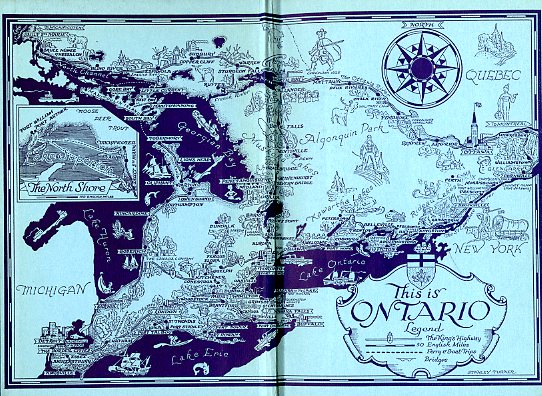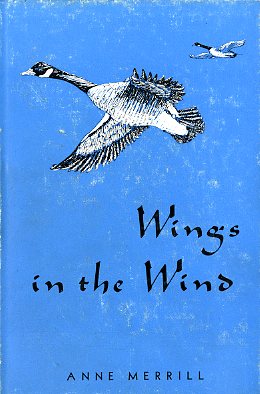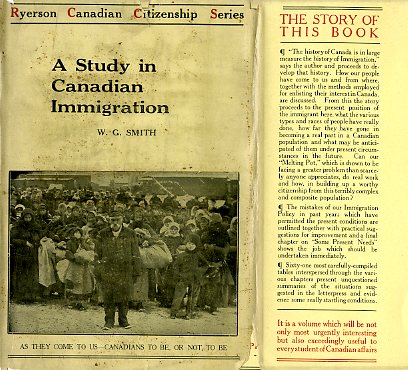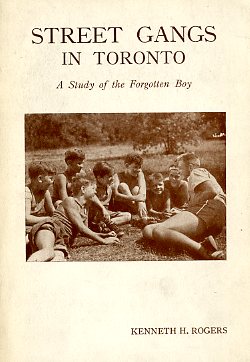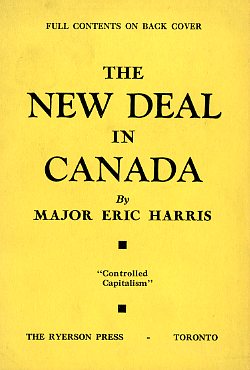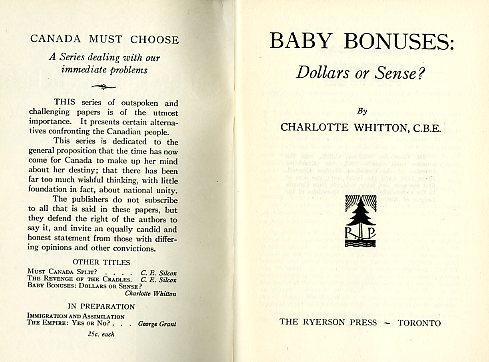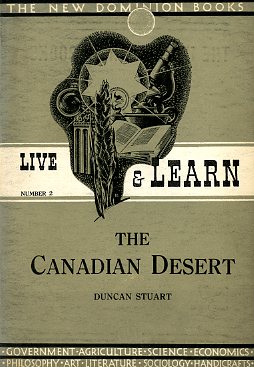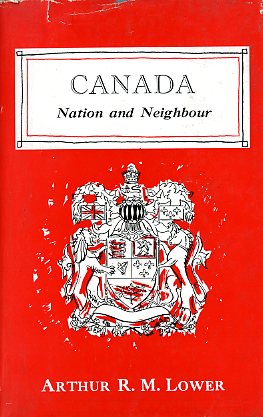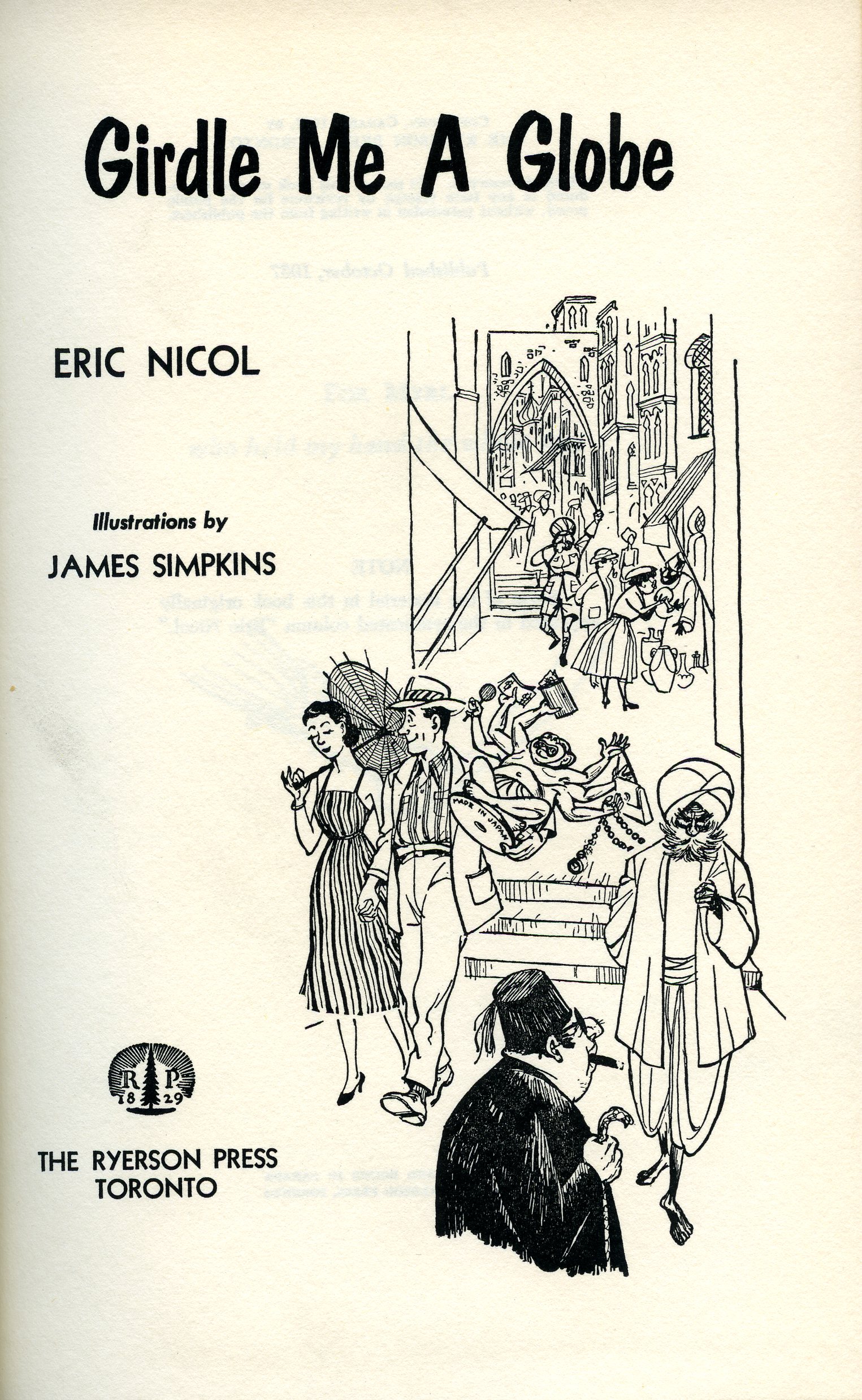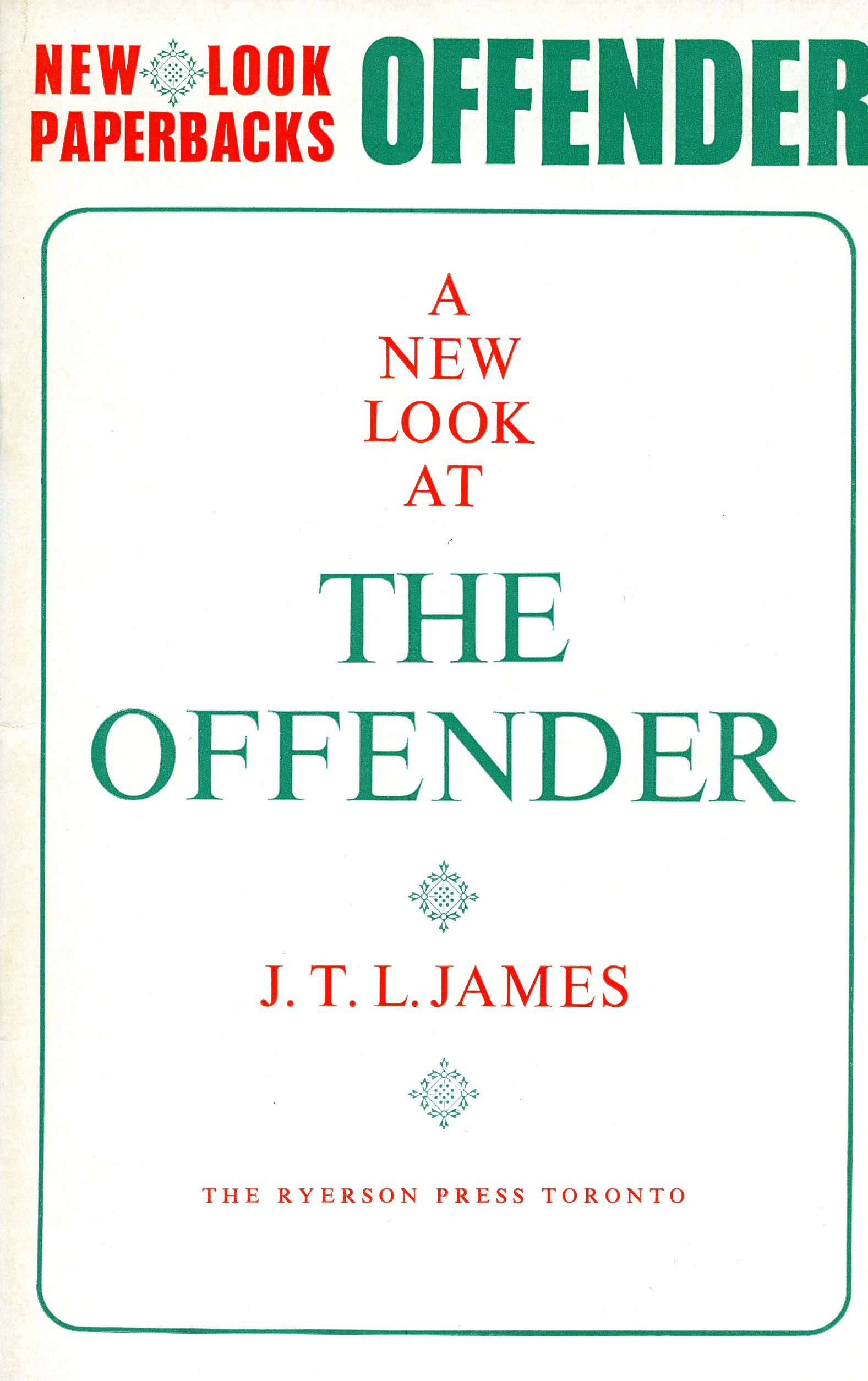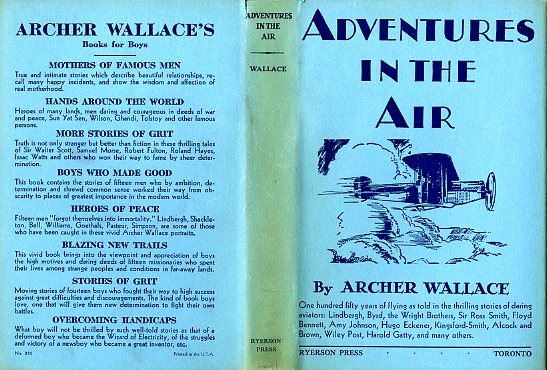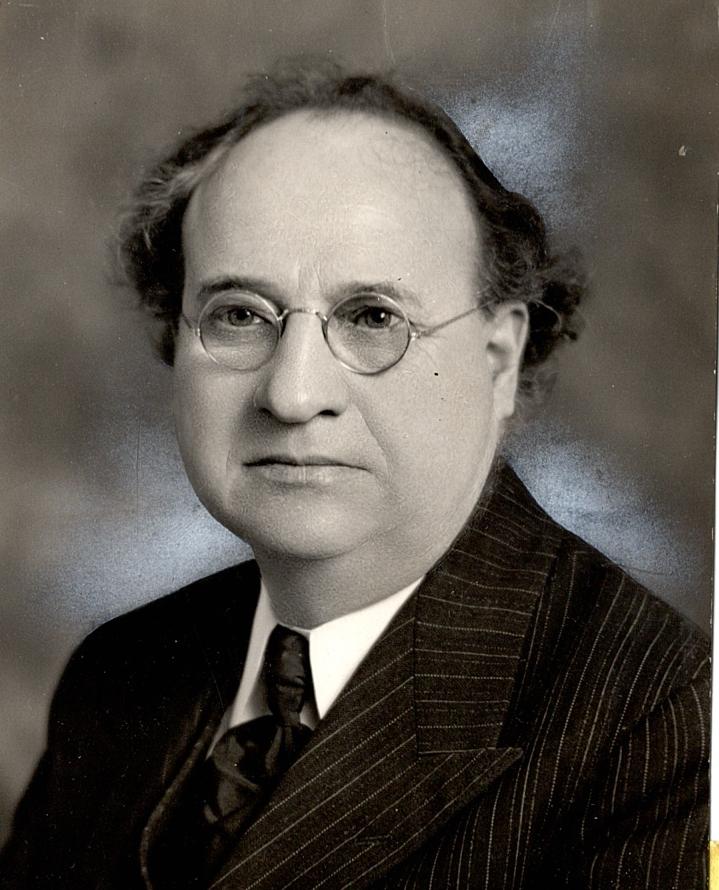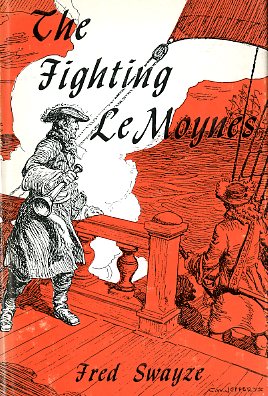From 1919 to 1970, the Ryerson Press imprint appeared on the title pages of numerous non-fiction books and booklets, covering fields such as history and biography; autobiography, memoir, and letters; travel; horticulture and nature; and politics, economics, society, education, religion, humour, and philosophy. Marketed largely to general readers, primarily through the vehicle of booksellers, non-fiction works issued by Ryerson Press appeared as either stand-alone titles or as volumes within specific series. The lion’s share of Ryerson’s non-fiction trade titles were produced for adult readers, but throughout the period a modest number of juvenile works also appeared on the firm’s non-fiction trade list, a complement to the many works it produced for children and adolescents under its robust engagement with educational publishing.
History and Biography
Over the course of fifty years, Ryerson Press exhibited a consistent and significant commitment to publishing in the areas of history and biography, particularly works with a Canadian focus. During this time, historical writing placed a strong focus on individuals as key players in the unfolding of historical events and movements. Hence, it is practical to discuss books of history together with biographies.

In the 1920s, as Lorne Pierce was still finding his feet as an editor, Ryerson Press drew on previously published historical works about Canada and issued new titles, as well. For example, a second edition of R.G. MacBeth’s The Romance of Western Canada appeared in 1920; the first edition had been issued under the organization’s earlier Briggs trade imprint in 1918. In terms of original new titles, the 1920s saw the appearance of George H. Locke’s Builders of the Canadian Commonwealth (1923), Adrian MacDonald’s Canadian Portraits (1925), and F.W. Howay’s Builders of the West (1929). Isabel Skelton highlighted pioneering women in The Backwoods Woman (1924). In 1929, George M. Wrong, Chester Martin, and Walter N. Sage published a more general history in The Story of Canada. Two biographies of provincial politicians also appeared in the 1920s: Margaret Ross’s Sir George Ross (1923) considered a former premier of Ontario, while D.C. Harvey’s Joseph Howe (1926) explored the life of one of Nova Scotia’s most prominent politicians and journalists. Finally, during the 1920s there appeared several works quite specific in their topical focus, including R.G. MacBeth’s The Romance of the Canadian Pacific Railway (1924); Louis Aubrey Wood’s A History of Farmers’ Movements in Canada (1924); G.G. McNab’s The Development of Higher Education in Ontario (1925); and F.W. Howay’s The Dixon-Meares Controversy (1929).

Histories and biographies issued in the 1930s are notable for the commitment Ryerson Press expressed toward more specialist or scholarly endeavours in both fields, producing books complete with indexes and other scholarly apparatus. Sandra Campbell reveals that, as early as 1925, Pierce had conceived of the Canadian Historical Studies series. Described as “a library of historical research,” Pierce served as its “general editor,” working in collaboration with ten associate editors drawn from the academy, libraries and archives, as well as artist C.W. Jefferys. One of the series’ titles was Percy J. Robinson’s Toronto during the French Régime (1933), which included a frontispiece by Jefferys, while its interior featured maps and photographs. As Campbell explains, “Pierce contrived to do this [series] despite the dismal book sales of the Depression years: he circumvented the problem of costs for such a venture by publishing small print runs (500 copies for three of the four works), for which all but fifty copies were sold by advance subscription.”1

Singular examples of historical studies also appeared during the 1930s, including University of Toronto professor Harold Innis’s landmark The Fur Trade in Canada (1930) and Dalhousie University professor George E. Wilson’s Life of Robert Baldwin (1933). Wilson had originally undertaken his biographical study of the Upper Canadian politician and advocate of responsible government for his doctoral dissertation. Through the mid-1930s, there appeared works in Canadian economic history in the Staples Industries in Canada series. Overseen by Innis,2 the series included Elwood S. Moore’s The Mineral Resources of Canada (1933; previously published as Canada’s Mineral Resources by Irwin and Gordon in 1929); Innis’s Problems of Staple Production in Canada (1933); Ruth Fulton Grant’s The Canadian Atlantic Fishery (1934); and Mary Quayle Innis’s Economic History of Canada (1935), whose dust jacket proclaimed it “the first economic history of Canada to be published,” further noting it was “an authoritative history, copiously documented, with more than six hundred references to contemporary accounts, state papers and other source material.” Decidedly more limited in scope was History of Science in Canada (1939). This collection of conference proceedings edited by H.M. Tory, director of the National Research Laboratories, offered brief historical essays about the development of specific fields of science in Canada, including astronomy, chemistry, geology, math and physics, medicine and biology, and zoology. The latter half of the 1930s also saw the launch of the series Relations of Canada and the United States, a joint initiative of Ryerson Press and the US-based Yale University Press that would continue until 1945.3 The series, which was sponsored financially by the Carnegie Endowment for International Peace, also involved Innis as an editor alongside Pierce. According to Campbell, the venture “was conceived as a groundbreaking examination of Canada in a North American rather than a traditional imperial context.”4 Included among its titles were Donald Creighton’s milestone Commercial Empire of the St. Lawrence (1937); Arthur Lower’s The North American Assault on the Canadian Forest (1938); Innis’s The Cod Fisheries (1940); and J.B. Brebner’s North Atlantic Triangle (1945).


In the 1940s, 1950s, and 1960s, Ryerson Press produced historical and biographical works on an expanded range of Canadian topics. Canadian social history found an early voice in John Kidman’s The Canadian Prison: The Story of a Tragedy (1947) and Vera Lysenko’s Men in Sheepskin Coats: A Study in Assimilation (1947). Lysenko’s substantial volume on the history of Ukrainian immigration to Canada included a bibliography, index, and some black and white images. Medical history in Canada was highlighted through Edwin Seaborn’s March of Medicine in Western Ontario (1944), Lloyd Stevenson’s Sir Frederick Banting (1946) (its subject best remembered as the co-inventor of insulin, though a painter as well), and Hugh W. McKervill’s Darby of Bella Bella: Wo-yo-la (1964). McKervill’s biography recounts George Darby’s years as a doctor in an Indigenous community in British Columbia from 1912 to 1959. Canadian journalists and newspapers received their due through G.V. Ferguson’s biographical sketch John W. Dafoe (1948), based on a nineteen years’ acquaintance,5 Orlo Miller’s A Century of Western Ontario: The Story of London, “The Free Press,” and Western Ontario, 1849-1949 (1949), and C. Frank Steele’s Prairie Editor: The Life and Times of Buchanan of Lethbridge (1961), a biography of William Asbury Buchanan, also a senator in later life. Canadian artists gained attention in biographies, such as Blodwen Davies’s Paddle and Palette: The Story of Tom Thomson (1930), and the booklets issued as the Canadian Art series, which included – all by Albert H. Robson – Cornelius Krieghoff (1937), J.E.H. MacDonald (1937), Tom Thomson (1937), Clarence A. Gagnon (1938, subsequently revised), A.Y. Jackson (1938), and Paul Kane (1938). In the 1940s, there appeared William Colgate’s much more substantial Canadian Art: Its Origins and Development (1943), as well as more booklets addressing specific artists, such as C.W. Jefferys (1944) by Colgate and The Group of Seven (1944) by Thoreau MacDonald. In turn, Kathleen Parlow: A Portrait (1967), authored by Maida Parlow French, featured the story of a Canadian musician once “acclaimed as the greatest violinist in the world.”6 Canadian sports received two general historical treatments by Henry Hall Roxborough: Great Days in Canadian Sport (1957) and One Hundred – Not Out: The Story of Nineteenth-Century Canadian Sport (1966). Vernon Kemp highlighted the history of Canadian policing in Scarlet and Stetson: The Royal North-West Mounted Police on the Prairies (1964); divided into two parts, the first section of the book focused on individuals, and the second on police work, including some specific cases. F.H. Ellis took on the history of flight in 50 Years of Adventure and Progress in Canadian Skies (1959) and Atlantic Air Conquest: The Complete Story of All North Atlantic Flights and Attempts during the Pioneer Years from 1910 to 1940 (1963), co-authoring the latter with E.M. Ellis, which also appeared in a British edition from William Kimber.

Education, war, and politics also found themselves subject to historical scrutiny. Newfoundland’s educational history received two treatments by Frederick W. Rowe, who published The History of Education in Newfoundland in 1952, and then returned with the heavily revised and expanded The Development of Education in Newfoundland in 1964. Both works included bibliographies and indexes. Canadian war-time history was highlighted in two books by John A. Swettenham – To Seize the Victory: The Canadian Corps in World War I (1965) and Allied Intervention in Russia, 1918-1919: And the Part Played by Canada (1967) – as well as Tom Coughlin’s The Dangerous Sky: Canadian Airmen in World War II (1968) and J.L. Granatstein’s Conscription in the Second World War, 1939-1945: A Study in Political Management (1969). Granatstein’s brief scholarly study was the first in the Frontenac Library, a series that would continue to have titles added after the late-1970 purchase of Ryerson Press by McGraw-Hill of Canada. Prior to the sale, I.K. Steele’s Guerillas and Grenadiers: The Struggle for Canada, 1689-1760 (1969) and Walter D. Young’s Democracy and Discontent: The Rise of the Third Parties in the Canadian West (1969) also appeared.
Regional or local histories and biographies issued by Ryerson during the middle decades of the century included William Coates Borrett’s Historic Halifax: In Tales Told under the Old Town Clock (1947), which is unusual for being a collection of historical sketches about events, people, and places linked to Halifax that were first made public through radio broadcasts. Nova Scotia’s most famous ship inspired the heavily illustrated Schooner Bluenose (1948). A coffee-table style book, it benefited from photographs taken by W.R. MacAskill, while the companion text by Andrew Merkel offered an historical account of the ship’s building and competitive racing. Another ship, along with its captain, was recognized by Dennis Jordan in Arctic Command: The Story of Smellie of the Nascopie (1955). The Nascopie was a Hudson’s Bay Company icebreaker commanded for many years by Captain Thomas Farrar Smellie. The 1950s also saw an addition to the Canadian Historical Studies series, with a focus on Hudson’s Bay: a reprint of Edward Umfreville’s 1790 work The Present State of Hudson’s Bay: Containing a Full Description of that Settlement and the Adjacent Country; and Likewise the Fur Trade, with Hints for Its Improvement, &c. &c. Edited by W. Stewart Wallace and issued in 1954, this scholarly reprint included a brief introduction, some annotation, and an index.

Historical studies of distinct Ontario geographies emerged in the 1950s and 1960s, often beneficiaries of local sponsorship. Neil F. Morrison’s Garden Gateway to Canada: One Hundred Years of Windsor and Essex County, 1854-1954 (1954) was a substantial volume complete with index, black and white line drawings, and photographs; the copyright page associates the book with the Essex County Historical Society. E.C. Drury’s All for a Beaver Hat: A History of Early Simcoe County (1959), in turn, was commissioned by the Simcoe County Council. A year earlier, in 1958, Marjorie Freeman Campbell highlighted another distinct region of Ontario in Niagara, Hinge of the Golden Arc. Campbell’s history of the Niagara peninsula included a map and black and white photographs. James Scott added another regional history, The Settlement of Huron County, in 1966; inclusive of appendices, bibliographical notes, and index, it was instigated by the Historic Committee of the County Council, which had “felt a more detailed history [of the county] was desirable.”7
Through the middle decades of the twentieth century, history and biography occasionally intersected with business and industry in certain Ryerson titles. Notable in this regard are W.R. Plewman’s Adam Beck and the Ontario Hydro (1947) and Elsie M. Pomeroy’s William Saunders and His Five Sons: The Story of the Marquis Wheat Family (1956). Also noteworthy is D.M. LeBourdais’s Sudbury Basin: The Story of Nickel (1953), whose costs were underwritten by Falconbridge Nickel Mines and which blends industrial and local history, with attention given to Sudbury’s history, geology, and mining. In addition to an index, it includes a map as its front endpaper, interior maps, and black and white photographs. Lorne Pierce: A Profile, written by book steward C.H. Dickinson, appeared in 1965, several years after the death of Ryerson Press’s long-serving editor. That same year, Mollie Gillen published The Masseys: Founding Family, beginning the story with this prominent business family’s arrival in Upper Canada in the early nineteenth century. In 1967, Scott Young and Astrid Young co-authored the illustrated biography O’Brien, which explored the life of Canadian multimillionaire businessman Michael John O’Brien.

Collecting and craftsmanship also found a place amongst Ryerson’s historical titles. In 1951, Ralph S. Mason published A Hundred Years of Canadian Stamps, 1851-1951. Gerald Stevens authored In a Canadian Attic (1955) – in which he discussed collecting in a range of areas, including books and stamps, textiles and furniture, and glass – as well as Early Canadian Glass (1961) and Canadian Glass, c. 1825-1925 (1967), with the latter expanding on the contents of the 1961 volume. George E.G. MacLaren produced Antique Furniture by Nova Scotian Craftsmen (1961); heavily illustrated with black and white photographs, it highlighted both what was made and the woods used in the construction of early Nova Scotian furniture. Huia G. Ryder followed in 1965 with Antique Furniture by New Brunswick Craftsmen.
Jeanne Minhinnick’s Early Furniture in Upper Canada Village, 1800-1837 (1964) and Audrey Spencer’s Spinning and Weaving at Upper Canada Village (1964) were two booklets in a series “devoted to various aspects of the social history of early Ontario, with particular reference to Upper Canada Village.”8 Ontario Premier John Robarts, who penned a general introduction for the series, praised Ryerson Press: “The publication of this series is another milestone achieved by The Ryerson Press in recording the history of our country. On behalf of the Government of Ontario,” he added, “I welcome the support given by this great publishing house in making meaningful for the people of Ontario a part of their priceless heritage.”9 These booklets were no doubt sold at Upper Canada Village, which opened near Morrisburg, Ontario in 1961.

In the mid-twentieth century, Ryerson Press continued a long-standing tradition by issuing works of religious history and biography. Many, but certainly not all, were specific to the United Church of Canada or its antecedent churches (Methodist, Congregational, or Presbyterian). In 1947, Isabel Skelton published A Man Austere: William Bell, Parson and Pioneer. This substantial biography, which recounted the life and work of a Presbyterian minister in the backwoods of Ontario, relied heavily on Bell’s journals. Ruth Bradley-St-Cyr attributes some of the publishing activity in religious history and biography in the 1960s to John Webster Grant, who succeeded Pierce as editor at Ryerson in 1960 and remained in the role until 1963. Bradley-St-Cyr notes that Grant’s tastes as an editor “ran … more to academic, theological works.”10 In 1960, James Nix highlighted the endeavours of two missionaries in Mission among the Buffalo: The Labours of the Reverends George M. and John C. McDougall in the Canadian Northwest, 1860-1876. The work included an apparatus of notes, bibliography, index, and maps. Ryerson Press editor John Webster Grant, also an established scholar of Canadian religious history, authored and published George Pidgeon: A Biography in 1962; this work highlighted the life of the first moderator of the United Church of Canada. Also in 1962, Goldwin French, an historian at McMaster University, published his more sweeping and highly scholarly Parsons and Politics: The Role of the Wesleyan Methodists in Upper Canada and the Maritimes from 1780-1855. That same year saw the appearance of Thomas C.B. Boon’s The Anglican Church from the Bay to the Rockies: A History of the Ecclesiastical Province of Rupert’s Land and Its Diocese from 1820 to 1950, issued with the support of both scholarly and church grants. In 1964 came W.H. Elgee’s The Social Teachings of the Canadian Churches. Protestant: The Early Period, before 1850. Religious and local history combined in Orlo Miller’s Gargoyles and Gentleman: A History of St. Paul’s Cathedral, London, Ontario, 1834-1964 (1966), which, complete with illustrations, examined the cathedral church of the Anglican Diocese of Huron. In 1966, Nan Shipley explored a nineteenth-century ministerial figure through The James Evans Story;11 in 1968, Margaret H. Brown’s MacGillivray of Shanghai (1968) examined the missionary activities of Donald MacGillivray in China; and then, in 1969, Clara Thomas published Ryerson of Upper Canada, a biography of Egerton Ryerson. Much in contrast to these biographies was John F. Hayes’s Wilderness Mission: The Story of Sainte-Marie-Among-the-Hurons (1969); produced in a large, coffee-table book format and heavily illustrated, it quite likely sold in the gift shop at the reconstructed historical site Sainte-Marie among the Hurons, which began operations in Midland, Ontario in the mid-1960s.
Autobiography, Memoir, and Letters

At Ryerson Press, history also found voice in first-person narratives in the forms of autobiographies, memoirs, and letters. Settler accounts of the west still appeared after 1930, with titles like When the West Was Young: Historical Reminiscences of the Early Canadian West (1933) by John D. Higginbotham, which was substantial in length and included an index; Sodbusters Invade the Peace (1954) by A.M. Bezanson, whose endpapers are maps of the Peace River region; and I Would Do It All Again: Reminiscences of the Rockies (1959) by Robert E. Campbell, which begins with boyhood memories of Ontario and then moves west. In 1969, Thomas F. Bredon resurrected a memoir from 1861, Lambert De Boilieu’s Recollections of Labrador Life, an account by a superintendent of a British firm. For this scholarly reprint, Bredon produced a special introduction and annotated the work.
Politicians past and present, including former prime ministers, were represented by works like The Life and Letters of the Right Honourable Sir Charles Tupper (1926) and Sir Wilfrid Laurier: Letters to My Father and Mother (1935), both edited by Lucien Pacauld. In addition, there were books like Recollections: Political and Personal (1938) by E.M. Macdonald, minister of national defence from 1923 to 1926, and Life Is an Adventure (1936) by R.J. Manion, leader of the Conservative Party of Canada from 1938 to 1940. After mid-century, government activity also gained new narrators through the accounts of civil servants. In Son of the North (1954), Charles Camsell, who eventually became deputy minister of mines in 1920, reflected on his forty-five years in the Public Service of Canada, much of it passed in the Northwest Territories. Careers in Canada’s foreign service provided the focus for both J.P. Manion’s A Canadian Errant: Twenty-five Years in the Canadian Foreign Service (1960; edited by Guy Sylvestre) and Dana Wilgress’s Memoirs (1967).
From mid-century onward, volumes appeared from authors engaged in many other professions. Wartime diaries and reminiscences included Armine Norris’s Mainly for Mother: Diary of Lieutenant Armine Norris, May 14, 1915-Sept. 28, 1918 (1919) and Alec McAlister’s Hi-Sky: The Ups and Downs of a Pinfeather Pilot (1944). The latter volume appeared sporting a striking dust jacket featuring a blue sky with the nose of a yellow airplane in the bottom left corner, and included cartoon illustrations in its interior. There was also Alan Easton’s 50 North: An Atlantic Battleground (1963). Easton described the work as “a factual account. The whole episode was recorded in 1945 while it was still fresh in my mind,” he explained. “All I have done recently is to put it into more readable form,” though dialogue was “drawn from memory and imagination” and he “appended fictitious names to some people.”12

From journalism and broadcasting came the “reminiscences” of J.F.B. Livesay, The Making of a Canadian (1947). It included details of the journalist’s childhood, as well as the founding of the Canadian Press; this work appeared posthumously and was edited by his wife, poet Florence Randal Livesay, who also included her own memoir of the man. Three further memoirs from journalists were those of J.H. Cranston, who authored Ink on My Fingers (1953), W.A. Hewitt, who produced Down the Stretch: Recollections of a Pioneer Sportsman and Journalist (1958), and Wilfrid Eggleston, who penned While I Still Remember: A Personal Record (1968). Eggleston also edited a collection of correspondence from a famous Canadian novelist, The Green Gables Letters from L.M. Montgomery to Ephraim Weber, 1905-1909 (1960). Representing television broadcasting, Alex Barris produced The Pierce-Arrow Showroom Is Leaking: An Insider’s View of the C.B.C. (1969). From the educational and cultural sectors came university professor Pelham Edgar’s Across My Path (1952), bookseller Dora Hood’s This Side Door (1958), and Royal Ontario Museum director Charles Trick Currelly’s I Brought the Ages Home (1956). Medical researcher Gordon Murray produced two memoirs: Medicine in the Making (1960) and Quest in Medicine (1963). Written for the “laity,” the first memoir focused on Murray’s medical experiments up to 1949, while the second considered his research activity from 1949 to 1962.13 Margaret F. Leatherbarrow offered a personal narrative of organic farming in Ontario in Gold in the Grass (1954), while Philip Sheridan Long highlighted Saskatchewan cattle ranching in The Great Canadian Range (1963). The title page of Long’s book includes a line drawing featuring cattle. Elsie McCall Gillies’s life in the far north, which she recounted to Eugenie Miles, resulted in North Pole Boarding House (1951); rendered as a series of sketches, it was illustrated with black and photographs. Anna G. Young, who described herself as “a sailor’s daughter,” published Off Watch: Today and Yesterday on the Great Lakes (1957), complete with endpapers of a map of the Great Lakes and black and white illustrations. The 1960s produced one memoir, Mutchmor (1965), by high-ranking United Church of Canada minister James Ralph Mutchmor, who spent a quarter century as secretary to the church’s board of evangelism and social service before being elected moderator of the United Church in 1962.
Travel

Travel narratives made regular appearances on Ryerson’s non-fiction trade list for the half-century that the imprint existed. Most often rendered in the first person, they frequently included illustrations (photographs or line drawings), as well as cartographic elements in the endpapers, the interior, or both. While their geographic focus was predominantly Canadian, some foreign travels did receive attention. Indeed, travels outside of Canada bracketed the period. At one end, J. Mackintosh Bell’s Side-Lights on the Siberian Campaign: Pictures of Russian Life before the War (1923) and Helen M. Edgar’s Dahabeah Days: An Egyptian Winter Holiday (1923); at the other, Helen Reid’s A World Away: A Canadian Adventure on Easter Island (1965), in which the author recounts how she attached herself to a medical expedition to Chile in the mid-1960s.
Percy Gomery stands out for two motor travel adventures. In 1922, he published his pioneering inter-provincial Canadian adventure, A Motor Scamper ’Cross Canada: A Human-Interest Narrative of a Pathfinding Journey from Montreal to Vancouver. Issued in a dust jacket sporting a tinted photographic image, it reveals the story of how “Mr. Percy Gomery of Vancouver made the first direct motor tour from Montreal to his own city, travelling every possible mile through Canadian territory.” Sponsored by the Vancouver Automobile Club, the “whole trip was undertaken as a pathfinding tour in the interests of the King’s International Highway, some day to be completed.”14 Two decades later, he was back – along with travelling companion and co-author Bernadette Gomery – with the story of a British motor trip, Hot and Cold Laid On. Burrowing in Britain: A Motor Trip through England and Scotland (1946).

Travel adventures penned by other women include Lynn Harrington’s Manitoba Roundabout (1951), as well as two Maritime journeys by motor car – Clara Dennis’s Down in Nova Scotia (1933) and Lilian Maxwell’s ’Round New Brunswick Roads (1951). Dennis was vice-president of the Nova Scotia Historical Society and a member of the Canadian Women’s Press Club. “In delightfully informal fashion,” states the dust jacket of her book, “the author writes of towns, roads, hills, valleys, and her experiences motoring through this picturesque Province by the sea.” Maxwell explored different areas of New Brunswick in separate chapters, interspersing her narrative with bits of history and accounts of chats with locals. J.F.B. Livesay took the opposite tack in Peggy’s Cove (1944) by focusing on just one location in Nova Scotia. Illustrated with Livesay’s own photographs, it reflects on multiple trips to Peggy’s Cove over many years; the book’s dust jacket pronounces it “a warm, human document, a delightful Canadian memoir of happy summers by the sea.”15 A decade later, J.H. Stewart Reid contributed another account focused on specific geographic areas in one province in his Mountains, Men and Rivers: British Columbia in Legend and Story (1954). Reid claimed the book was neither history nor travel, then explained that writing the book had “provided … a reasonable sort of excuse for many summers of travel and loafing and fishing in certain favourite spots in British Columbia.”16 O.T.G. Williamson’s The Northland Ontario (1946), which contains illustrations by Evan MacDonald, is a somewhat different travel book since it features a train trip through northern Ontario, in which the author variously reflects on the region’s agriculture, mining, forestry, and scenery, among other things. Marjorie Wilkins Campbell tackled the whole of the province more conventionally in Ontario (1953), opting for chapters with a regional focus.

Blodwen Davies, W.P. Percival, and Will R. Bird each published more than one travel narrative under the Ryerson imprint. Davies’s contributions included Storied Streets of Quebec (1929) and Storied York: Toronto Old and New (1931), creating a link between the two volumes through her titles. The 1929 edition of Storied Streets of Quebec issued by Ryerson appeared in a paper edition; that same year, the book also emerged under the imprint of Montreal publisher Louis Carrier, raising the possibility that it was a co-publishing venture. The book appeared under the Ryerson imprint again in 1931. Davies’s Storied York, issued in hardback and about thirty pages greater in length, blended history with travel. Percival similarly published books on different cities with companion titles, in his case The Lure of Quebec (1941) and The Lure of Montreal (1945). Percival’s book on Quebec City comes across as a historically oriented travel guide, its stated “purpose … to instruct on a fairly wide scale and to whet the appetite for more. Its use will tend to prevent an aimless waste of time in wandering about at random, and missing any salient features.”17 The Lure of Montreal, in turn, was sufficiently popular for him to produce a heavily revised edition in 1964. Bird also stuck to one province, first authoring This Is Nova Scotia (1950) and subsequently Off-Trail in Nova Scotia (1956). The latter book continued to be reprinted into the early 1970s under the McGraw-Hill Ryerson imprint.

Ryerson steadily issued travel books with titles beginning with “This Is” for two decades. Will R. Bird’s This Is Nova Scotia was far from the first. The phenomenon began with Katherine Hale’s This Is Ontario in 1937, which appeared in a revised edition in 1946. Other such titles included This Is Canada (1944), edited by Donald Buchanan; This Is Newfoundland (1949), edited by Ewart Young; This Is New Brunswick (1951) by Jessie I. Lawson and Jean M. Sweet; This Is Alberta (1952) and This Is British Columbia (1958), both by Ken E. Liddell; and This Is Saskatchewan (1953) by journalist Robert Moon. By the early 1950s, the firm had designated the various “This Is” titles, as well as several other travel books – Helen Champion’s Over on the Island (1939) and the aforementioned The Lure of Quebec, The Lure of Montreal, and Manitoba Roundabout – as part of its Ryerson Travel Library series.18 One suspects expediency in this collective designation, given the lack of uniformity in the physical design across volumes. Even in the case of “This Is” volumes within the series, the approach to the contents of these works varied markedly. Hale’s substantial volume, blessed with beautiful endpapers and written in the first person, was more conventional in form; it explored “Ontario, old and new; the established south, and the story of the opening north; well-known motor routes and surprising byways.”19 In marked contrast stands This Is Newfoundland, whose preface states an intention to introduce the rest of Canada to its newest province.20 Far from a typical travel narrative, the work comprises an autograph poem about the province’s sailors by Newfoundland native E.J. Pratt, followed by a prologue by the poet, then an historical introduction to the province by Brian Cahill, and then a series of biographical sketches of prominent Newfoundlanders by premier Joseph Smallwood, each accompanied by a portrait by Yousuf Karsh. Buchanan’s This Is Canada is different again, predominantly a photographic essay made possible because its editor was granted access to the National Film Board of Canada’s photograph collection. The only comparable travel title to Buchanan’s effort – one not designated part of the Travel Library series – was Clifford Wilson’s Pageant of the North: A Photographic Adventure into Canada’s Northland (1957), a coffee table book heavy with photographs by various photographers and sparse in text, complete with an index to contributors.
Horticulture and Nature


Concern for the natural world also found a regular place on Ryerson’s non-fiction trade book list. Gardening was a recurrent topic. In 1933 there appeared Henry J. Moore’s The Culture of Hardy Perennials and Biennials, tapping into an abiding preoccupation of Canadian gardeners. In the 1950s came Thelma B. Boucher’s One Gardener to Another (1956), which the CNIB reissued in braille the same year it was published by Ryerson. Roscoe A. Fillmore produced four gardening books for Ryerson in less than a decade: Green Thumbs: The Canadian Gardening Book (1953); The Growing Question: Answers to Your Gardening Problems (1957); Roses for Canadian Gardens (1959); and The Perennial Border and Rock Garden (1961). Green Thumbs was sufficiently popular to be reissued in a Ryerson Paperback edition in 1967.
For readers whose engagement with the natural world extended beyond gardening, Ryerson published such popular works as E. Chesley Allen’s Our Northern Year: Stories and Songs of the Canadian Seasons (1937) and Pete McGillen’s Outdoors with Pete McGillen (1955). McGillen held the position of “outdoors editor” at the Toronto Telegram, and his book comprised a collection of material originally written for newspaper and radio broadcast. Birds commanded attention in Anne Merrill’s Wings in the Wind (1954); Evelyn M. Richardson’s Living Island (1965), which focused on the birds and natural history of Bon Portage Island, Nova Scotia; and Roy Ivor’s I Live with Birds (1968), published the same year by American publisher Follett. In its final half dozen years, Ryerson issued three weightier volumes by F.H. Montgomery, whose name is now associated with a wildlife sanctuary in Ontario’s Region of Waterloo: Weeds of Canada and the United States (1964); Plants from Sea to Sea (1966); and Trees of Canada and the Northern United States (1970).
Politics, Economics, Society, Education, Religion, Humour, and Philosophy
Contemporary topics – ranging widely across politics, economics, society, education, religion, humour, and philosophy – also found a place among Ryerson Press’s trade book offerings throughout the half century of the imprint’s existence. Titles in these subject areas were variously authored by academics, journalists, and practitioners.


In the 1920s, Ryerson Press issued W.G. Smith’s A Study in Canadian Immigration (1920) as part of the Ryerson Canadian Citizenship series, while in the 1930s there appeared the decidedly pragmatic Highway to Health (1933) by Donald Solandt. Liberally illustrated with photographs and diagrams in black and white, Highway to Health was both a general health and first aid manual. In the 1920s and 1940s, concern for the intersection of crime and society found voice in The Convicted Criminal and His Re-Establishment as a Citizen (1926) by Alfred Lavell, Canadian Penal Institutions (1929) by C.W. Toppings, and Street Gangs in Toronto: A Study of the Forgotten Boy (1945) by Kenneth H. Rogers. Rogers was general secretary of the Big Brother Movement in Canada.

In the 1930s and 1940s, the state of the Canadian economy and society during the Depression and the Second World War commanded attention. In 1931 there appeared Depression and the Way Out by W.W. Swanson, professor of economics at the University of Saskatchewan. This book, according to its author, was an “attempt … to analyze the effects of the Depression on the social and economic status of the great agrarian community, and to offer tentative solutions of the difficulties with which our farmers are confronted.”21 Eric Harris tackled the Depression from another angle in New Deal in Canada (1934). Issued in paper covers, it offered a reflection on how Canada might achieve a fair economic system. Almost a decade later, another paperback title, William Yendall’s The Common Problem (1942), gave further consideration to Canadian economic issues, covering such topics as distribution of wealth, capitalism, employer and employee relations, and postwar adjustments. The same year, Harry Cassidy contributed Social Security and Reconstruction in Canada. British Columbian by birth, Cassidy was a professor of social welfare at the University of California, Berkeley. The book undertook a province-by-province assessment of the Canadian social service system, noting its failures. In 1944, journalist and CBC correspondent Raymond Davies identified “Canada’s farthest Northwest” as a place of future growth and economic hope for the country in Arctic Eldorado, a book in which he set out a four-year plan.22
Many of Ryerson’s non-fiction titles on contemporary topics in the 1930s and 1940s appeared as part of series. These series overlapped in the timing of their production and addressed myriad concerns. These series included Canada Must Choose, Contemporary Affairs, Live and Learn, and School for Parents.

Canada Must Choose, as Campbell observes, “featured short works by Canadian intellectuals on a variety of pressing topics.”23 Subtitled “a series dealing with our immediate problems,” most of these works contained a provocative question mark as part of their titles. Booklets issued in the series included, among others, Family Allowances in Canada: Facts versus Fiction (1945) by Margaret Gould; The Empire: Yes or No? (1945) by George Grant; Canada and World Security (1945) by Vincent Price; Must Canada Split? (1945) and The Revenge of the Cradles (1945), both by C.E. Silcox; Baby Bonuses: Dollars or Sense? (1945) by Charlotte Whitton; and Civvy Street, Red Light or Green? (1945) by O.T.G. Williamson.
The series Contemporary Affairs, whose titles also appeared as booklets in paper covers, was associated with the Canadian Institute of International Affairs, “an unofficial and non-political body founded in 1928 to promote an understanding of international questions and problems, particularly in so far as these relate to Canada and the British Empire.”24 Campbell notes that this “series took aim at political, economic and social issues of the day.”25 It included works such as Good Neighbours (1940) by Lawrence J. Burpee; Canada’s Trade Policy and the War (1940) by L.B. Jack; India Today: The Background of the Indian Nationalist Movement (1941), compiled by W.E. Duffett, A.R. Hicks, and G.R. Parkin; More Farmers for Western Canada: A Study of the Possibilities of Post-War Agricultural Settlement in the Prairie Provinces (1941) by Andrew Stewart; French Canadian Opinion on the War, January, 1940-June, 1941 (1942) by Elizabeth H. Armstrong; and The New Western Front: A Geographical Approach (1942) by Griffith Taylor. Works continued to appear in this series under the Ryerson Press imprint into the 1950s; in the 1960s, the Canadian Institute of International Affairs began to issue titles under its own imprint.

Live and Learn (some of whose titles were also marked as part of the Dominion Books series) also comprised booklets issued in paper covers. Eclectic in subject, the series included, among other works, B.A. Fletcher’s Child Psychology for Parents (1938); W.G. Frisby’s How to Arrange a Public Dinner (1938) and The Conduct of a Meeting (1938); Duncan Stewart’s The Canadian Desert: An Attempt to Stay the Loss of the West (1938); John Macdonald’s The Corner Stone of Democracy: The Discussion Group (1939); Hilda Ridley’s The Post-War Woman (1941); W.E.C. Harrison et al.’s Canada: The War and After (1942); Alan George Kirkby’s The Key Problem of the Peace: A United States of Europe (1943); Wilfrid Sanders’s Jack and Jacques: A Scientific Approach to the Study of French and Non-French Thought in Canada (1943); J.C. Cameron’s The Ethics of Labour Relations (1944); and Kenneth H. Rogers’s Boys Are Worth It (1944).
The School for Parents series, which had its roots in a nation-wide CBC broadcast of the same name, was decidedly more focused in its subject and authorship. In this series, co-sponsored by the National Committee for Mental Hygiene (Canada), there appeared Cheating Your Children (1947), Emotional Climate in the Home (1947), Family Team Work (1947), Growing Up: One to Six (1948), and Skills for Living (1948), all authored by Canadian educational psychologist S.R. Laycock.
From the late 1940s, non-fiction titles that were scholarly and reflective in nature also appeared on Ryerson’s list. In 1948, the firm issued its first book drawn from Queen’s University’s Chancellor Dunning Trust (CDT) lectures: The Freedom of the Individual in Society by T.E. Jessop. The CDT’s general purpose was “to promote understanding and appreciation of the supreme importance of the dignity, freedom, and responsibility of the individual person in human society.”26 In 1952, another work encompassing three lectures originally given under the auspices of the CTD appeared: Herbert Butterfield’s Liberty in the Modern World. The sixth series of CTD lectures, contained in Notable Images of Virtue: Emily Brontë, George Meredith, W.B. Yeats by C. Day Lewis, was published by Ryerson in 1954. In 1955, the focus of the CTD turned to Canada with Press and Party in Canada; this volume contained lectures by two scholars, G.V. Ferguson and Frank H. Underhill.

Beyond the CDT volumes, from mid-century Ryerson issued additional essay collections, alongside single-authored studies of intellectual bent. A collection of essays of varied authorship appeared in 1952 under the title The Heritage of Western Culture. Edited by R.C. Chalmers, six of the seven essays it contained were originally written in response to the United Church of Canada’s commission on culture. The essays probed different eras of western culture, going right back to the Greeks and Romans; authors found in the volume included philosopher John Irving and literary critic Northrop Frye. Also appearing that year was historian Arthur R. M. Lower’s Canada: Nation and Neighbour. In this work, Lower extended his traditional disciplinary boundaries. In his foreword, he declared the book neither a “history of policy” nor “a history of Canada’s relations with the external world,” but rather “an attempt to describe the ground out of which grows the opinion that sooner or later determines policy.” While his book contained some historical chapters, he further explained, they were not concerned with the actions of statesmen, “but with the forces that at given periods have molded public opinion.”27 In 1956, Ryerson published two further scholarly works: NATO: The Economics of an Alliance (1956) by R.S. Ritchie, a study whose “origins [were] in the discussion of a special study group which met during 1952 and 1953 to discuss Canada’s position in the NATO alliance”;28 and R.C. Chalmers and John A. Irving’s co-edited The Light and the Flame: Modern Knowledge and Religion, which contained seven essays in which Canadian scientists and scholars “discussed significant developments during the last fifty years in the sciences, philosophy and theology.”29 Complementing these works by scholars was a book-length study and one essay collection by journalists. In 1958, Willson Woodside took on the question of university expansion in The University Question: Who Should Go? Who Should Pay? For the multi-authored Why the Sea Is Boiling Hot: A Symposium on the Church and the World (1965), which was initiated by the United Church of Canada, journalists’ “not noted for pious forbearance” had been asked to assess the church from the outside.30 Its authors included journalists Michael Barkway, Pierre Berton, June Callwood, Joan Hollobon, and Eric Nicol.

By the mid-1960s, Nicol was a prominent Ryerson author. He was one of two journalists to dominate Ryerson’s list in the field of humour, the other being Gregory Clark. A humourist who for many years produced a regular column for Vancouver’s Province, Nicol’s first book with Ryerson had appeared in the 1940s – Sense and Nonsense (1947). Many others followed over the next two decades, including, among others, three recipients of the Stephen Leacock Memorial Award for Humour: The Roving I (1950), Shall We Join the Ladies? (1955), and Girdle Me a Globe (1957). Clark worked as a regular reporter for the Toronto Star from 1911, but along the way began to write humour for the newspaper’s companion publication, the Toronto Star Weekly. According to Jock Carroll, “The most popular of these featured the comic misadventures of Clark and his hunting and fishing companion, cartoonist Jimmie Frise.”31 Frise illustrated Clark’s stories. The collaborators departed for the Montreal Standard in 1947, then Frise died suddenly the following year. Clark began publishing collections with Ryerson in 1959, beginning with The Best of Gregory Clark. Three more appeared in the 1960s, including War Stories (1964), which won the Leacock Memorial Award. Ryerson reprinted all four Clark books in its Ryerson Paperback series in 1968.

The 1960s saw the emergence of further new series and new stand-alone titles. The earliest series of the decade, Encounter Books, included works of modest length, such as Darwin in Retrospect (1960), a collection of five scholarly essays by Carleton University faculty edited by H.H.J. Nesbitt et al.; The Economists versus the Bank of Canada (1961) by H. Scott Gordon; and Why I Am a Separatist (1962) by Marcel Chaput, a treatise on separation translated by Robert A. Taylor. The situation of contemporary Quebec generated sufficient attention to result in two stand-alone titles at mid-decade: Quebec, the Not-So-Quiet Revolution (1965) by Thomas Sloan and Convergence: Essays from Quebec (1966) by Jean Le Moyne, translated by Philip Stratford. Sloan’s work offered chapters on what was happening in the province in terms of politics, religion, economy, separatism, and nationalism, while Le Moyne positioned his volume as “the main items in a personal testimony delivered little by little … over a period of twenty years.”32 By the time these works appeared, Ryerson Press had commenced a second series, New Look Paperbacks. Published in cooperation with the Anglican and United Churches of Canada, booklets in the series included J.A. Davidson’s A New Look at Morals (1964); J.T.L. James’s A New Look at the Offender (1964); Donald M. Mathers’s A New Look at Belief (1964); Joseph C. McClelland’s A New Look at Vocation (1964); Louis O’Neill and Wilfred F. Butcher’s A New Look at Protestants and Catholics (1964); J. Arthur Boorman’s A New Look at Personal Discipline (1965); and Nancy Montizambert’s A New Look at Television (1965). Stand-alone titles of the late-1960s included A.R.M. Lower’s This Most Famous Stream: The Liberal Democratic Way of Life (1967) and Donald Peacock’s Journey to Power: The Story of a Canadian Election (1968), which explored Pierre Elliott Trudeau’s rise to power.
The decade of the sixties closed with another series, Shaping Canada’s Environment, which Ryerson co-published with magazine conglomerate Maclean-Hunter. The series’ first four titles emerged before the buy out of Ryerson by McGraw-Hill of Canada; at least one title came out after it. The four pre-sale titles were Impact of Oil (1969) by Earle Gray; Developing Water Sources: The St. Lawrence Seaway and the Columbia/Peace Power Projects (1969) by Ronald E. Richardson, Walter G. Rooke, and George H. McNevin; Building for People: Freeway and Downtown – New Frameworks for Modern Needs (1970) by Ronald E. Richardson, George H. McNevin, and Walter G. Rooke; and Pollution: Canada’s Critical Challenge (1970) by Frank Morgan.
Juvenile Non-Fiction

Ryerson reached young readers through its numerous educational textbooks, but it also brought out a modest number of non-fiction trade books for children on a range of topics. Science was the focus of The Science of Things about Us authored by Charles E. Ruth and Amy Winslow and published in 1926, and Heroes of Science written by Joseph Cotler and Haym Jaffe and issued in 1931 by Ryerson in Toronto and Little Brown in Boston. History was a popular subject. The history of aeronautics was addressed by Archer Wallace in Adventures in the Air (1932). The Story of Britain and Canada: From the Earliest Times to the Present (1934) was written by Gilbert Patterson and illustrated by C.W. Jefferys and Edith Maclaren. Jefferys’s three-volume The Picture Gallery of Canadian History for young readers appeared in 1942. J.W. Chafe, assisted by Sybil Shack, produced Early Life in Canada (1946) for Ryerson’s Guidebook series in social studies. Animals, including accounts of how to hunt caribou and seals by Vilhjalmur Stefannson, was the subject of Lords of the Wilderness (1933), compiled by Zella Mannning. In 1941, Joseph M. Scott, assisted by Lilian Bishop, explored multiple forms of transportation from Canada’s past in Our Story of Travel and Transport, giving attention to travel by water, rail, road, and air.

Biographies included Archer Wallace’s Poor Men Who Made Us Rich (1933), which offered brief biographies of fourteen historical figures from different fields of endeavour including art (Rembrandt), literature (John Milton, Robert Burns), music (Mozart), and philosophy (Socrates). Wallace’s Adventures in the Air and Poor Men Who Made Us Rich were issued simultaneously by Harper Brothers of New York. Musical biography received a longer treatment later in the 1930s in Violet Hendry’s Masters of Music: Stories of the World’s Greatest Composers for Boys and Girls (1937), which was part of the Ryerson Music series.

Fred Swayze’s The Fighting Le Moynes (1958) told the story of New France’s Charles le Moyne and his ten sons, the most notable of whom was third son Pierre le Moyne d’Iberville, a victorious soldier on land and sea. Sports journalist Andy O’Brien turned to contemporary matters in Young Hockey Champions, specifically written for juvenile readers. First issued in 1969, the book contained interviews with, and observations about, thirteen hockey superstars. At the close of the decade, the firm began publishing its Ryerson Science in Action series, which included The Outdoors: Studies for Open Places (1969) by William MacKillican, Audrey E. Wilson, and Ivan Woolley, Studies for Woodlands (1970) by David Bates, and Studying Soil (1970) by William MacKillican. Titles continued to appear in the series after the sale to McGraw-Hill. In 1970, Ryerson also published Canadian editions of three short historical works by Marie Neurath: They Lived Like this in Ancient Crete; They Lived Like this In Ancient Egypt; and They Lived Like this in Ancient Mesopotamia. These books had been issued previously in the United States and Britain; two of the three had also appeared in earlier Canadian editions from McGraw-Hill Company of Canada.
1 Sandra Campbell, Both Hands: A Life of Lorne Pierce of Ryerson Press (Montreal/Kingston: McGill-Queen’s UP, 2013) 327.
2 Campbell describes the collaborations of Pierce and Innis in Both Hands, pp. 327-40.
3 Campbell 329-35.
4 Campbell 329.
5 G.V. Ferguson, John W. Dafoe (Toronto: Ryerson Press, 1948) 1.
6 Maida Parlow French, Kathleen Parlow: A Portrait (Toronto: Ryerson Press, 1967) 2.
7 James Scott, The Settlement of Huron County (Toronto: Ryerson Press, 1965) [v].
8 John P. Robarts, Introduction, in Spinning and Weaving at Upper Canada Village, by Audrey Spencer (Toronto: Ryerson Press, 1964) n. pag.
9 Robarts.
10 Ruth Bradley-St-Cyr, “The Downfall of the Ryerson Press,” PhD dissertation, U of Ottawa, 2014. 56-57.
11 Nearly eighty years earlier, the firm had issued John McLean’s James Evans: Inventor of the Syllabic System of the Cree Language (1890) under its Methodist Mission Rooms imprint.
12 Alan Easton, 50 North: An Atlantic Battleground (Toronto: Ryerson Press, 1963) author’s note.
13 Gordon Murray, Quest in Medicine (Toronto: Ryerson Press, 1963) vii.
14 Percy Gomery, A Motor Scamper ’Cross Canada: A Human-Interest Narrative of a Pathfinding Journey from Montreal to Vancouver (Toronto: Ryerson Press, 1922) interior left flap, dust jacket.
15 J.F.B. Livesay, Peggy’s Cove (Toronto: Ryerson Press, 1944) interior left flap, dust jacket.
16 J.H. Stewart Reid, Mountains, Men and Rivers: British Columbia in Legend and Story (Toronto: Ryerson Press, 1954) v.
17 W.P. Percival, The Lure of Quebec (Toronto: Ryerson Press, 1941) dust jacket.
18 Ken E. Liddell’s This Is Alberta (Toronto: Ryerson Press, 1952) includes beside its title page a list of titles in the Ryerson Travel Library.
19 Katherine Hale, This Is Ontario (Toronto: Ryerson Press, 1937) interior left flap, dust jack.
20 Ewart Young, ed., Preface, in This Is Newfoundland (Toronto: Ryerson Press, 1949) v.
21 W.W. Swanson, Depression and the Way Out (Toronto: Ryerson Press, 1931) vi.
22 Raymond Davies, Arctic Eldorado (Toronto: Ryerson Press, 1944) interior left flap, dust jacket.
23 Campbell 406.
24 Andrew Stewart, More Farmers for Western Canada: A Study of the Possibilities of Post-War Agricultural Settlement in the Prairie Provinces, Contemporary Affairs 9 (Toronto: Ryerson Press, 1941) copyright page.
25 Campbell 406.
26 Herbert Butterfield, Liberty in the Modern World (Toronto: Ryerson Press, 1952) v.
27 A.R.M. Lower, Canada: Nation and Neighbour (Toronto: Ryerson Press, 1952) [iii].
28 R.S. Ritchie, NATO: The Economics of an Alliance (Toronto: Ryerson, 1956) acknowledgements.
29 R.C. Chalmers and J.A. Irving, The Light and the Flame: Modern Knowledge and Religion (Toronto: Ryerson Press, 1956) vii.
30 Ernest Marshall Howse, Foreword, in Why the Sea Is Boiling Hot: A Symposium on the Church and the World (Toronto: Ryerson Press, 1965) iii.
31 Jock Carroll, “Greg Clark,” Canadian Encyclopedia Online. https://thecanadianencyclopedia.ca/en/article/greg-clark.
32 Jean Le Moyne, Convergence: Essays from Quebec, trans. Philip Stratford (Toronto: Ryerson Press, 1966) v.





